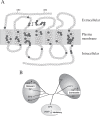Physiology and pathophysiology of prostanoid receptors
- PMID: 24367153
- PMCID: PMC3859365
- DOI: 10.2183/pjab/83.296
Physiology and pathophysiology of prostanoid receptors
Abstract
Prostanoids, consisting of prostaglandins (PGs) and thromboxanes (TXs), are oxygenated products of C20 unsaturated fatty acids. They include PGD2, PGE2, PGF2 α , PGI2, and TXA2. Given that aspirin-like nonsteroidal anti-inflammatory drugs exert their actions by suppressing prostanoid production, prostanoids have been implicated in processes inhibited by these drugs, including inflammation, fever, and pain. Prostanoids also contribute to vascular homeostasis, reproduction, and regulation of kidney and gastrointestinal functions. How prostanoids exert such a variety of actions had remained unclear, however. Prostanoids are released outside of cells immediately after their synthesis and exert their actions by binding to receptors on target cells. We have identified a family of eight types or subtypes of G protein-coupled receptors that mediate prostanoid actions. Another G protein-coupled receptor was also identified as an additional receptor for PGD2. Genes for these receptors have been individually disrupted in mice, and analyses of these knockout mice have not only elucidated the molecular and cellular mechanisms of known prostanoid actions but also revealed previously unknown actions. In this article, I review the physiological and pathophysiological roles of prostanoids and their receptors revealed by these studies.
Keywords: G protein–coupled receptor; cyclooxygenase; prostaglandin; thromboxane.
Figures











Similar articles
-
The roles of prostanoids in infection and sickness behaviors.J Infect Chemother. 2008 Aug;14(4):270-8. doi: 10.1007/s10156-008-0622-3. Epub 2008 Aug 17. J Infect Chemother. 2008. PMID: 18709530 Review.
-
Prostaglandin receptor signaling in disease.ScientificWorldJournal. 2007 Sep 1;7:1329-47. doi: 10.1100/tsw.2007.182. ScientificWorldJournal. 2007. PMID: 17767353 Free PMC article. Review.
-
Roles of prostanoids in the pathogenesis of cardiovascular diseases: Novel insights from knockout mouse studies.Pharmacol Ther. 2011 Feb;129(2):195-205. doi: 10.1016/j.pharmthera.2010.09.004. Pharmacol Ther. 2011. PMID: 20920529 Review.
-
[Pathophysiological roles of the prostanoids in the cardiovascular system: studies using mice deficient in prostanoid receptors].Nihon Yakurigaku Zasshi. 2003 Nov;122(5):384-90. doi: 10.1254/fpj.122.384. Nihon Yakurigaku Zasshi. 2003. PMID: 14569157 Review. Japanese.
-
Prostanoids and inflammation: a new concept arising from receptor knockout mice.J Mol Med (Berl). 2009 Oct;87(10):1015-22. doi: 10.1007/s00109-009-0500-1. Epub 2009 Jul 17. J Mol Med (Berl). 2009. PMID: 19609495 Review.
Cited by
-
The Interaction of Human Papillomavirus Infection and Prostaglandin E2 Signaling in Carcinogenesis: A Focus on Cervical Cancer Therapeutics.Cells. 2022 Aug 15;11(16):2528. doi: 10.3390/cells11162528. Cells. 2022. PMID: 36010605 Free PMC article. Review.
-
Visual quantification of prostaglandin E2 discharge from a single cell.Cell Struct Funct. 2023 Dec 7;48(2):241-249. doi: 10.1247/csf.23047. Epub 2023 Oct 7. Cell Struct Funct. 2023. PMID: 37813623 Free PMC article.
-
Effects of selexipag and its active metabolite in contrasting the profibrotic myofibroblast activity in cultured scleroderma skin fibroblasts.Arthritis Res Ther. 2018 May 2;20(1):77. doi: 10.1186/s13075-018-1577-0. Arthritis Res Ther. 2018. PMID: 29720235 Free PMC article.
-
Monascus purpureus M-32 fermented soybean meal improves the growth, immunity parameters, intestinal morphology, disease resistance, intestinal microbiota and metabolome in Pacific white shrimp (Litopenaeus vannamei).Anim Nutr. 2024 Mar 30;17:283-296. doi: 10.1016/j.aninu.2024.03.009. eCollection 2024 Jun. Anim Nutr. 2024. PMID: 38800738 Free PMC article.
-
Calcium transients trigger switch-like discharge of prostaglandin E2 in an extracellular signal-regulated kinase-dependent manner.Elife. 2024 Jan 26;12:RP86727. doi: 10.7554/eLife.86727. Elife. 2024. PMID: 38276879 Free PMC article.
References
Publication types
LinkOut - more resources
Full Text Sources
